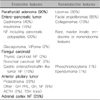Abstract
Multiple endocrine neoplasia (MEN) is defined as a disorder with neoplasms in two or more different hormonal tissues in several members of a family. MEN1, or Wermer's syndrome, is inherited as an autosomal dominant trait. This syndrome is characterized by neoplasia of the parathyroid glands, enteropancreatic tumors, anterior pituitary adenomas, and other neuroendocrine tumors with variable penetrance. Inherited medullary thyroid carcinoma (MTC) consists of MEN2A, MEN2B, and familial medullary thyroid cancer (FMTC). The identification of hereditary MTC has been facilitated in recent years by direct analysis of germline RET proto-oncogene mutation.
Figures and Tables
 | Fig. 1A case of MEN2B with mucosal neuromas (A, B) and pheochromocytoma (C, arrows). Marked distension of the ascending and transverse colon (short arrow) and enlargement of right adrenal gland with multifocal low attenuation (long arrow) are noted. A RET protooncogene germline mutation in codon 918, exon 16 (D). Figures adapted from Kim et al.17)
|
 | Fig. 2RET tyrosine kinase receptor mutations in MEN2, FMTC and sporadic MTC. FMTC: familial medullary thyroid cancer, HSCR: Hirschsprung disease, MEN: multiple endocrine neoplasia, SMTC: sporadic medullary thyroid cancer. Figure adapted from de Groot et al.20)
|
 | Fig. 3Multistep process for MEN2 genetic testing. Figure adapted from Eng et al.24)
|
Table 1
Expressions of MEN1 with estimated penetrance (in parentheses) at age 40 yr

NF: nonfunction. Data were adapted from Brandi et al.1)
Table 2
A representative program of tests and test schedules to screen for tumor expression in a highly likely carrier of MEN1 mutation (identified from MEN1 mutation or other criteria)

Data were adapted from Brandi et al.1)
Table 3
Clinical subtypes of MEN2

FMTC: familial medullary thyroid carcinoma without MEN, HPTH: hyperparathyroidism, MEN: multiple endocrine neoplasia, MTC: medullary thyroid carcinoma, PHEO: pheochromocytoma. Data were adapted from Eng.13)
Table 6
American Thyroid Association risk level and prophylactic thyroidectomy testing and therapy

Data were adapted from Kloos et al.23)
References
1. Brandi ML, Gagel RF, Angeli A, Bilezikian JP, Beck-Peccoz P, Bordi C, et al. Guidelines for diagnosis and therapy of MEN type 1 and type 2. J Clin Endocrinol Metab. 2001. 86(12):5658–5671.
2. Pelizzo MR, Boschin IM, Bernante P, Toniato A, Piotto A, Pagetta C, et al. Natural history, diagnosis, treatment and outcome of medullary thyroid cancer: 37 years experience on 157 patients. Eur J Surg Oncol. 2007. 33(4):493–497.

3. Larsson C, Skogseid B, Oberg K, Nakamura Y, Nordenskjold M. Multiple endocrine neoplasia type 1 gene maps to chromosome 11 and is lost in insulinoma. Nature. 1988. 332(6159):85–87.

4. Chandrasekharappa SC, Guru SC, Manickam P, Olufemi SE, Collins FS, Emmert-Buck MR, et al. Positional cloning of the gene for multiple endocrine neoplasia-type 1. Science. 1997. 276(5311):404–407.

5. Waldmann J, Fendrich V, Habbe N, Bartsch DK, Slater EP, Kann PH, et al. Screening of patients with multiple endocrine neoplasia type 1 (MEN-1): a critical analysis of its value. World J Surg. 2009. 33(6):1208–1218.

6. Rizzoli R, Green J 3rd, Marx SJ. Primary hyperparathyroidism in familial multiple endocrine neoplasia type I. Long-term follow-up of serum calcium levels after parathyroidectomy. Am J Med. 1985. 78(3):467–474.

7. Uchino S, Noguchi S, Sato M, Yamashita H, Yamashita H, Watanabe S, et al. Screening of the Men1 gene and discovery of germ-line and somatic mutations in apparently sporadic parathyroid tumors. Cancer Res. 2000. 60(19):5553–5557.
8. Sato M, Miyauchi A, Namihira H, Bhuiyan MM, Imachi H, Murao K, et al. A newly recognized germline mutation of MEN1 gene identified in a patient with parathyroid adenoma and carcinoma. Endocrine. 2000. 12(3):223–226.

9. Geerdink EA, Van der Luijt RB, Lips CJ. Do patients with multiple endocrine neoplasia syndrome type 1 benefit from periodical screening? Eur J Endocrinol. 2003. 149(6):577–582.

10. Goudet P, Murat A, Binquet C, Cardot-Bauters C, Costa A, Ruszniewski P, et al. Risk factors and causes of death in MEN1 disease. A GTE (Groupe d'Etude des Tumeurs Endocrines) cohort study among 758 patients. World J Surg. 2010. 34(2):249–255.

11. Sipple JH. The association of pheochromocytoma with carcinoma of the thyroid gland. Am J Med. 1961. 31(1):163–166.

12. Steiner AL, Goodman AD, Powers SR. Study of a kindred with pheochromocytoma, medullary thyroid carcinoma, hyperparathyroidism and Cushing's disease: multiple endocrine neoplasia, type 2. Medicine (Baltimore)
. 1968. 47(5):371–409.

13. Eng C. Seminars in medicine of the Beth Israel Hospital, Boston. The RET proto-oncogene in multiple endocrine neoplasia type 2 and Hirschsprung's disease. N Engl J Med. 1996. 335(13):943–951.

14. Jaquet AJ. Ein fall von metastasierenden amyloidtumoren (lymphosarkom). Virchows Arch. 1906. 185:251–267.

15. Williams ED. Histogenesis of medullary carcinoma of the thyroid. J Clin Pathol. 1966. 19(2):114–118.

16. Webb TA, Sheps SG, Carney JA. Differences between sporadic pheochromocytoma and pheochromocytoma in multiple endocrime neoplasia, type 2. Am J Surg Pathol. 1980. 4(2):121–126.

17. Kim SW, Lee BJ, Kim JY, Lee KD, Lee BJ, Kim IJ. Analysis of RET gene point mutation with multiple endocrine neoplasia type 2B. J Clinical Otolaryngol. 2007. 18(1):79–85.

18. Mathew CG, Chin KS, Easton DF, Thorpe K, Carter C, Liou GI, et al. A linked genetic marker for multiple endocrine neoplasia type 2A on chromosome 10. Nature. 1987. 328(6130):527–528.

19. Eng C, Smith DP, Mulligan LM, Nagai MA, Healey CS, Ponder MA, et al. Point mutation within the tyrosine kinase domain of the RET proto-oncogene in multiple endocrine neoplasia type 2B and related sporadic tumours. Hum Mol Genet. 1994. 3(2):237–241.

20. de Groot JW, Links TP, Plukker JT, Lips CJ, Hofstra RM. RET as a diagnostic and therapeutic target in sporadic and hereditary endocrine tumors. Endocr Rev. 2006. 27(5):535–560.

21. Waguespack SG, Rich TA, Perrier ND, Jimenez C, Cote GJ. Management of medullary thyroid carcinoma and MEN2 syndromes in childhood. Nat Rev Endocrinol. 2011. 7(10):596–607.

22. Bachelot A, Lombardo F, Baudin E, Bidart JM, Schlumberger M. Inheritable forms of medullary thyroid carcinoma. Biochimie. 2002. 84(1):61–66.

23. American Thyroid Association Guidelines Task Force. Kloos RT, Eng C, Evans DB, Francis GL, Gagel RF, et al. Medullary thyroid cancer: management guidelines of the American Thyroid Association. Thyroid. 2009. 19(6):565–612.





 PDF
PDF ePub
ePub Citation
Citation Print
Print




 XML Download
XML Download